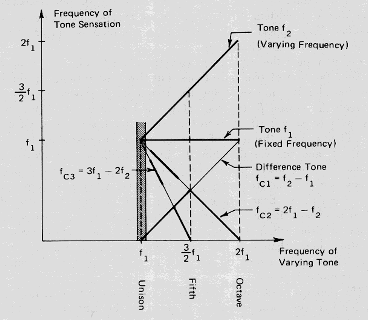
Combination Tones
Combination tones sometimes result when two tones are sounded together[*]. For example, when the frequency of a frequency variable sine tone fvar increases beyond the critical band from a unison position with a fixed sine tone ffixed, additional pitch sensations appear. They are most easily perceived at high intensity levels. These pitches are not present in the original sound stimulus - they appear as the result of a so-called non linear distortion of the acoustical signal in the ear. They are not present at the oval window membrane but are thought to be caused by the non-linear response of the cochlea. We say that the cochlea produces a non-linear or distorted response.
It can be shown experimentally that sweeping the frequency of fvar slowly upwards from the unison at ffixed to an octave above at 2ffixed causes pitch sensations other than these two tones. As fvar sweeps upwards away from ffixed one or more lower pitched rising tones are perceived. As fvar approaches 2ffixed (the octave) the lower tones "disappear".
The most easily perceived of these combination tones is the one whose frequency is given by the difference of the component frequencies:
fc1 = fvar- ffixed called the difference tone.
For fvar close to ffixed the difference tone is nothing but the beat frequency. fc1 must be at least 20-30 Hz to be heard as a tone. As fvar increases fc1 increases until when fvar= 2ffixed (ie an octave above) , then
fc1= 2ffixed - ffixed= ffixed.
That is, the frequency of the difference tone coincides with the frequency of the lower component ffixed.
When fvar is half way between ffixed and 2ffixed ,i.e. fvar = 3/2 (ffixed) ( a pure perfect fifth), then the difference tone has a frequency:
fc1 = (3/2)ffixed - ffixed
= (1/2)ffixed
which corresponds to the frequency of a tone one octave below ffixed.
The two other tones most easily identifiable correspond to the frequencies
fc2 = 2ffixed - fvar , and
fc3 = 3ffixed - 2fvar
Their "pitch paths" both decrease as fvar increases from the unison towards the fifth.
Note that the frequencies of fc1and fc2 coincide (=1/2 ffixed) at the fifth - when fvar = 3/2 ffx.
(see below for summary.)

Note again that this is a "close-up" mapping of what happens with beat frequencies.
Extension Topics
Second Order Effects:
Beats of Mistuned Consonances
Fundamental Tracking
Periodicity Pitch and the Theory of Hearing